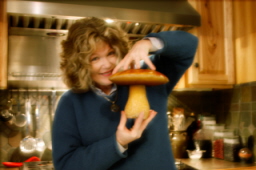Sourdough Ciabatta - Second Try
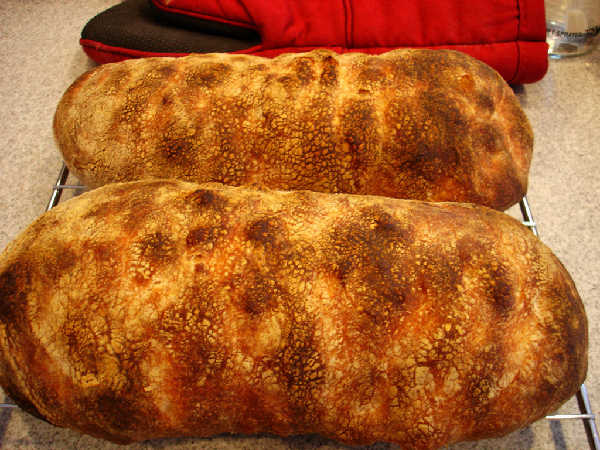 Sourdough Ciabatta - Firm Starter Version (loaves)
Sourdough Ciabatta - Firm Starter Version (loaves)
 Sourdough Ciabatta - Firm Starter Version (crumb and loaf)
Sourdough Ciabatta - Firm Starter Version (crumb and loaf)
 Sourdough Ciabatta - Firm Starter Version (crumb)
Sourdough Ciabatta - Firm Starter Version (crumb)
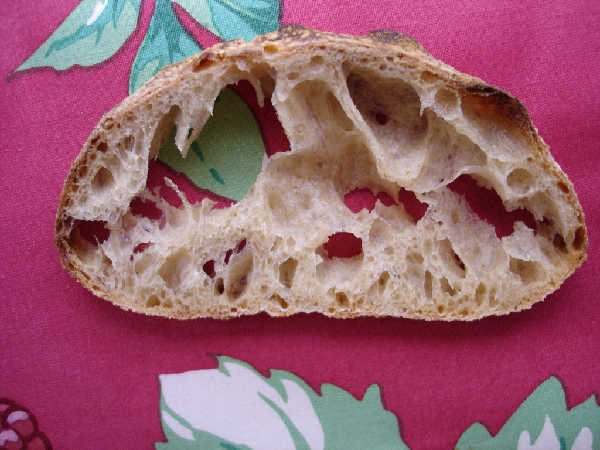 Sourdough Ciabatta - Firm Starter Version (slice)
Sourdough Ciabatta - Firm Starter Version (slice)
Sourdough Ciabatta - Firm Starter Version
One of the favorite family breads seems to be ciabatta, and this sourdough version is clearly preferred (wolfed down) by my kids for its flavor. I've achieved a little better crust and crumb with yeasted versions, particularly the one in Maggie Glezer's "Artisan Baking", but the sourdough flavor is hard to beat, especially with salty grilled left over meats in sandwiches. The recipe is loosely based on the BBA (Reinhart) "Poolish Ciabatta", as well as incorporating ideas from Maggie Glezer's version in "Artisan Baking".
This is a work in progress, but I like the way this one turned out - my second blog entry on this recipe. The flavor is a little mild, which may mean I need to lengthen and/or retard the fermentation, or maybe use somewhat more ripe starter, an exercise for future attempts.
Many thanks to various contributors to this site as always, and especially in this case to Zolablue, who encouraged me to pay more attention to ciabatta with some just great photos and discussions about how to achieve better holes in ciabatta through hydration, proper handling, and flour choice, all of which were used here, (again) after much feedback from my first blog entry on the topic.
This version has been changed to use a lower percentage - around 22% - of flour contributed by the starter, and the starter itself is a firm starter, instead of the usual 100% hydration starter I had been using. My theory here was to try the flavors from the firm starter, as well as lower the percentage of starter in the recipe. The higher percentage seems to cause problems with the texture of the dough before it gets a chance to rise. Zolablue and I have both had good success with a "hybrid" method where some yeast is added to the dough to compensate. However, I was curious to see if I could find a percentage that might work with a pure sourdough raise. The result was a higher rise, but I seem to have made the hydration a little high, as the holes are a little too extreme for my tastes. However that should be solved by simply lowering the hydration on my next try. Also, I ran out of KA AP flour, so I substituted some "sifted red whole wheat flour" from Heartland Mills, which is called "Golden Bufallo". They say it is a "high extraction" flour, i.e. the germ and endosperm is in the flour, but most of the bran has been sifted out. I have found it to be a very good flour for rustic breads. It gives the crumb a darker color and there is a nuttier flavor than with KA. Well, I wish I had just stuck with KA organic AP in this case, as the result was a little more rustic than I had in mind. I suppose there are those who would treasure this result and call it something on the way from white ciabatta to "ciabatta integrale".
Photos of process have been posted for this ciabatta using a firm "recipe starter". Don't worry, you can build this starter from any consistency starter you may have by just setting the hydration to 65%, letting it rise by double and refrigerating overnight. A spreadsheet is also posted showing weights in ounces or grams.
Recipe Starter:
- 2 oz 100% hydration starter (Use whatever starter you like. The intention is a 65% hydration firm starter)
- 4.5 oz bread flour (I used KA Bread Flour)
- 2.5 oz water
The day before this bread was baked, I took my "BBA style barm", a 100% hydration starter fed with KA Bread Flour, out of the refrigerator. It had been fed within the last couple of days and was fresh and strong at the time it was refrigerated. I mixed the starter with KA Bread Flour and water in the amounts above and kneaded it for a couple of minutes to form a dough. I then put the dough in a container sprayed with a little oil and left it to rise by double - about 4 hours. Once it had risen by double, I refrigerated it to be used the next day in the dough. Note that it is not necessarily a good thing to let the dough rise by more than double or become overly ripe, as it may affect the consistency of the dough the next day.
Dough:
- 9 oz of recipe starter from above
- 12.5 oz AP Flour (I used KA organic AP flour
- 5 oz high extraction red wheat flour (like Golden Buffalo from Heartland Mills, use AP for a less rustic result)
- 2 oz KA Rye Blend Flour
- 16.5 oz water
- 0.5 oz salt (14 grams)
- 1/2 tsp diastatic malted barley flour
Autolyse:
Mix all flours but 5 oz of AP flour, diastatic malted barley flour, and water together and mix on low speed just enough to get a well mixed batter. Let this sit 20 minutes. I'm trying to simplify the processing relative to the last version by using my mixer for a change.
Mix:
Cut up the starter into small pieces and mix it in along with the salt. Run the mixer for a minute or so to get a good mix of ingredients in what should still be a thick batter consistency. Then, add in the remaining 5 oz of flour as you run the mixer on a low speed. It should turn into a very slack dough after another couple of minutes. I tried to show a picture of it hanging off the mixer dough hook, so check out the photos of the process linked up above.
Bulk Fermentation and Folding: (about 4 hours)
Make a fairly thick bed of flour on the counter about 12 inches square. Using a dough scraper, pour the dough out into the middle of the bed of flour. Allow it to rest for a few minutes. Then, fold the dough by flouring or wetting your hands, then grabbing one side of the dough and lifting and stretching it, folding it over itself like a letter. Do this for all 4 sides. Brush flour off the dough as you fold over the sides that were in contact with the bed of flour. You don't want to incorporate much flour into the dough as you fold. After folding, shape it gently back into a rectangle or square, turn it upside down and push the seams underneath. Place it in a rising bucket or other rising container of your choice. I spray mine with oil to make it easy to remove the dough. I also spray the top of the dough and then dust lightly with flour. Cover the container and allow to rise. Repeat the folds approximately every hour three more times. You just turn it back out on a light bed of flour - you need less flour once the dough is folded a couple of times. Always brush off flour as you fold it to avoid incorporating flour in the dough. If the dough seems very resistant to stretching, only fold it from two directions instead of four. You don't want the dough to get really stiff from too much folding. The amount of folding you will need will be more if you have more water and less if you have less water. Note that even an ounce can make a very big difference in the consistency of the dough. The dough should rise by double over a total of 4 hours. My dough was sitting at about 76F, so you may have to wait a little longer in a cooler room temperature environment. Stop folding if the dough gets too stiff. This means you didn't get as slack a dough as I had here, probably because of less water or maybe because of a different style of flour. No problem, just fold when it is stretchy, but let it rest and rise if not.
This is the first time I used Zolablue's suggestion to put the dough in a container as in Glezer's Artisan Baking, as opposed to doing it on the counter as in the BBA by Reinhart, and as done in my previous blog entry on sourdough ciabatta. I felt it worked well and had a few advantages. First, you can tell easily how much the dough has risen. That's a good thing because the poke test is hard to interpret with this very slack dough. Second, flour doesn't get stuck to the bottom because of the wet dough sitting on the counter in a bed of flour during the rise. I found that the crust was easier to control. Before I was having trouble with big chunks of wet flour paste getting stuck on the dough. I think that can actually look nice and be a characteristic of ciabatta crust, but it seemed to be a little too much that way with the wetter doughs I've been using to make these ciabattas. The last thing is that you can control the bulk fermentation temperature much more easily with the dough in a container that you can move to a good spot for rising.
Shaping:
Divide the dough into four pieces of equal size, roll them in the bed of flour to dust the cut ends, and let them rest a few minutes. To shape, take one of the four pieces, stretch it out and roll it or fold it over itself very gently. With ciabatta this amounts to a gently stretch and fold like a letter. You want to create some tension in the surface of the dough by folding it over itself that way. I sometimes have to roll it up a little more than just a letter fold to give it some tension. Then if you place the dough folds down on a couche, it will seal up the seams. Use the couche to create folds for the ciabatta and then nestle the folds between supports, such as bags of flour or whatever system you may have similar to what you might do for baguettes. I usually also roll the ends underneath a little to get some tension in the ends of the dough.
Final Proof:
Let them rise in the couche for about 1.5 hours, until they are puffy and have increased significantly in volume.
I baked two loaves at a time, so I proofed two loaves for 1.5 hours and two loaves for 2 hours. Da Crumb Bum - you may be right about these SD ciabatta recipes being on the edge of overproofing. I found that the first batch had darker, harder crust, whereas the second was a little bit on the pale side, even though I baked both for the same amount of time in an oven that I know was fully heated and at the same temperature. Also, the oven spring was much better on the first batch. I believe the steam conditions, temperature, and handling were very, very close to identical for both bakes.
Prepare to Bake:
Preheat oven to 500F (yes, you can probably do it without preheating, as mentioned elsewhere on the site, but it's not what I did this time). While that is going on, take each loaf out of the couche, gently stretch it in one direction by about double, lay it on a peel, maybe with parchment paper underneath, maybe sprinkled with corn meal or similar, and use your fingertips to flatten out and dimple the loaf. You can press down fairly firmly to feel the peel underneath. It sounds crazy, but the loaf will bounce back just fine in the oven if it is not overproofed. This step is important to avoid "separation of crust and crumb" or "one gigantic hole" instead of many holes. It also evens out the loaf so it has a nicer shape after baking.
Bake:
Place loaves in the oven and lower temperature to 450F. Bake for about 15 minutes, until the internal temperature is around 209F (I'm near sea level), rotating them after about 9 minutes. You can bake them longer to get a darker, harder crust, or less to get a lighter softer crust. If you bake them in a dry oven for shorter times, you will get a softer crumb and a crispy, thin, lighter crust that is very good if you intend to use these for sandwiches. If you want a chewier, drier bread with a tastier, harder crust, then bake them more and use steam. Then it is a great bread to just dip in olive oil or use like french bread with dinner. The loaves should spring up from their "flattening" with your fingertips, such that not much evidence is left of the dimples you made with your fingers.
The oven spring on these was better than in my first version. The dough also seemed handle more easily. It seemed to stretch without tearing during the folds and didn't seem as sticky. I was happier with the lower percentage of starter in this dough. I wish I had the KA organic AP for the recipe, just for comparison, and also because I liked the soft white crumb, but this one is good for a more rustic effect. The size of these loaves was about 10in x 5in x 2.5in. This is a better oven spring than last time. They were about 3 inches high right after baking, but they shrunk back down to 2.5 inches after cooling off. That's still quite a bit better than the previous version, which was about 2 inches tall. It's probably true that the best of both worlds would be hybrid method, i.e. add about 1/2 to 3/4 tsp of instant yeast to either this recipe or my previous version and get a little bit faster rise and a softer, lighter crumb, as well as getting the sourdough flavors in there.
Cool:
Let bread completely cool, if you can stand to wait.
This bread is especially good for sandwiches, sliced in half and then sliced along the "flat" direction to open up like a hamburger bun. It is great for burgers, steak sandwiches, ham, or just with olive oil and pepper.


 Today I
Today I received a sample package from Filbert foods of T-55 flour they had created for import. It smelled about the same as my Harvest King and KA AP flour but had a slightly darker color than the King Arthur. I couldn't detect any smell that would distinguish it from the others.
received a sample package from Filbert foods of T-55 flour they had created for import. It smelled about the same as my Harvest King and KA AP flour but had a slightly darker color than the King Arthur. I couldn't detect any smell that would distinguish it from the others.


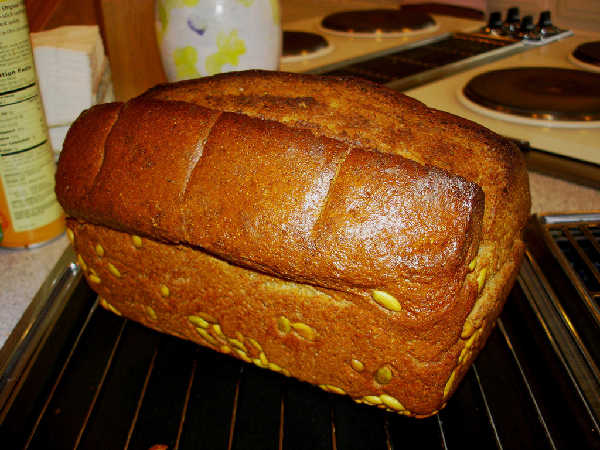 Marcel's Grandmother's Spelt Bread (1)
Marcel's Grandmother's Spelt Bread (1)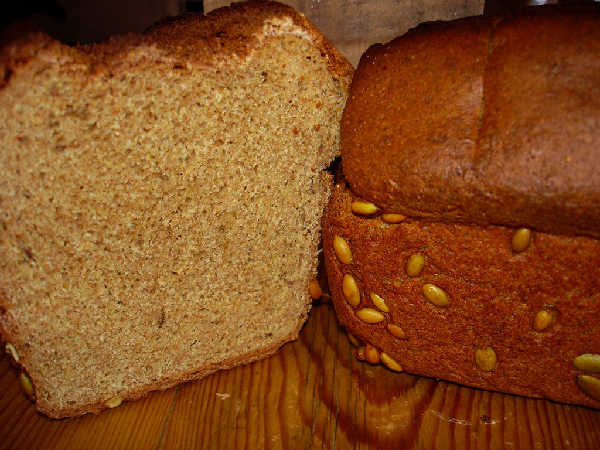 Marcel's Grandmother's Spelt Bread (2)
Marcel's Grandmother's Spelt Bread (2)











 Sourdough Ciabatta - Firm Starter Version (loaves)
Sourdough Ciabatta - Firm Starter Version (loaves) Sourdough Ciabatta - Firm Starter Version (crumb and loaf)
Sourdough Ciabatta - Firm Starter Version (crumb and loaf) Sourdough Ciabatta - Firm Starter Version (crumb)
Sourdough Ciabatta - Firm Starter Version (crumb) Sourdough Ciabatta - Firm Starter Version (slice)
Sourdough Ciabatta - Firm Starter Version (slice)